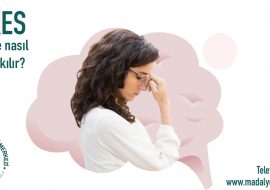
Skills for Coping with Difficult Emotions from Toxic Positivity
Emotions are often classified as positive and negative. Positive emotions describe more fluid and enjoyable feelings, while negative emotions encompass more challenging and uncomfortable ones. This classification can sometimes lead to tendencies such as suppressing, ignoring, and denying emotions perceived as negative. However, humans are capable of experiencing both fluid and challenging emotions, such as happiness, joy, excitement, as well as more challenging and tight emotions like anger, sadness, and anxiety. Being able to experience both types of emotions is vital for individuals, and each emotion serves a function. All emotional experiences can indicate met and unmet needs and situations in one’s life. For example, a child who feels upset and hurt because of derogatory nicknames can learn that aggressive and violent behaviors, such as bullying, are unacceptable by referencing the challenging emotion he experienced. To allow the child to reference his emotions, he should be able to notice how other people’s behaviors affect him, name the emotion he feels, and express it. The ability to do this depends on accepting that both fluid and enjoyable emotions and challenging and tight emotions are human, vital, and functional.
On the other hand, there are numerous case examples and scientific studies showing that intense and powerful challenging emotions and negative perspectives can negatively affect physical and psychological health. People’s tendency to avoid challenging emotions such as anger, fear, anxiety, and sadness, and replace these emotions with pleasant ones, can be understood from this perspective. However, trends like positive attitudes and giving room only to positive emotions can turn toxic and harm individuals psychologically. This tendency is called “toxic positivity.” Toxic positivity is an attempt by individuals to generalize their positive outlook and experiences of positively defined emotions in an dysfunctional and excessive way in their lives, in other words, to always direct themselves and their environment towards positive and optimistic directions regardless of what happens. This excessive effort, which turns into toxicity, can lead to consequences such as the suppression of emotions perceived as negative, alienation from oneself and the environment. For example, responding to a person who has been laid off from their job and feels sad with a statement like “There are others worse off than you” can be an example of toxic positivity. The person hearing this statement may feel guilty about the emotions they experience due to being laid off and may feel angry, thinking that they are not understood, and that their emotion is being rejected. However, life events such as being laid off from a job, moving to a new place, or separating from a person involve loss and change and can make individuals feel emotions such as grief, anger, and sorrow. Accepting and expressing these emotions is quite functional in coping with this loss and managing the emotions brought about by the loss. When toxic positivity comes to this point, it can lead to significant emotional experiences and distance the individual from the stage of emotional growth and development. Emotions that are suppressed and attempted to be avoided do not disappear and can accumulate, returning at appropriate times and often in the form of emotional outbursts. When the underlying emotions of explosions accumulate invisibly, the person may sometimes have difficulty understanding what brought them to the point of explosion because they have become alienated from their emotions and needs. As a result, the person may be deprived of important information he needs to learn from his emotions.
During the current pandemic period, toxic positivity has become a rapidly spreading trend, especially on social media, with the slogan “good vibes only.” Trends such as focusing on personal development in various areas such as cooking, sports, art during the time spent at home due to restrictions, can be shown as an example of this tendency. Individuals with this perspective, trying to give happiness and positive outlook with attitudes such as “looking at the good side” or “turning the crisis into an opportunity” to people who have difficulty coping with various losses brought about by the pandemic, can turn into toxic positivity. The reason is that the unexpected and beyond the usual pandemic process can cause various psychological effects such as losing control of one’s own life, shaking feelings of safety and security, and bringing about challenging emotions like anger, helplessness, hopelessness, and anxiety. Individuals experiencing these effects may not always be able to switch to positive thinking or pleasant emotions. As a result, despite the approach of “good vibes only,” individuals who cannot switch to positive attitudes may feel guilt, shame, and loneliness, thinking that they cannot cope with the emotions triggered by the pandemic. At this point, positive attitude can turn into a toxic point and create negative psychological effects on the individual.
In addition to toxic positivity, personal development during the pandemic period is said to have a functional aspect in coping with the difficulties brought about by the pandemic. This aspect can be explained through the life line technique of family therapy. According to this technique, each individual and family has life lines formed from positive and negative life events. Within family therapy, this line can be recreated with functional purposes such as bringing out the strengths of the individual and the family and emphasizing how they cope with difficulties. Individuals on social media trying to show how they developed themselves during the pandemic and acquired new skills in various areas can be said to have reorganized their life lines for this period with functional purposes such as coping with the difficult effects of the pandemic. In this way, the pandemic period is reframed as a period in which individuals can demonstrate their strengths and cope with difficulties. Tragic optimism can also be mentioned in terms of coping skills with difficult and traumatic emotional experiences. Tragic optimism means maintaining hope and reinterpreting one’s life in the face of challenging or traumatic events. At this point, it can be said that the individual not only experiences fluid and enjoyable emotions but also accepts and experiences challenging emotions, reshaping his life after this difficulty through the process called “post-traumatic growth and development.”
In conclusion, always having a positive outlook or looking at the positive side may not be easy within challenging or traumatic life events, including the current pandemic period. Recognizing that each emotion provides important information about the emotional needs and experiences of the individual; allowing every emotion to be experienced, acknowledging that sometimes there may be no energy or desire to take action or produce, accepting that agitated reactions (crying, shouting, etc.) as a result of emotional intensity can be human, and realizing that sometimes experiencing ups and downs or falling into pessimism can also be part of the human experience are crucial and important. It is not always possible to look at everything from a positive perspective and navigate among pleasant emotions. Allowing room for every emotion and experience, learning important life lessons from these experiences, and recognizing that each individual is unique and that even in the commonality of the challenging experience, unique processes are involved, are more humane and functional in terms of recognizing one’s own emotions and needs and taking action through these experiences throughout life.












